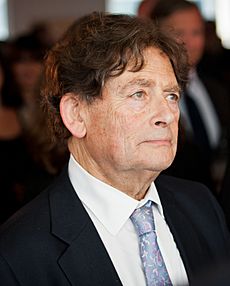Lawson Boom facts for kids
The Lawson Boom was a time in the United Kingdom during the late 1980s when the economy grew very quickly. It is named after Nigel Lawson, who was the Chancellor of the Exchequer (like the finance minister) for Margaret Thatcher's government.
This period was called a "boom" because the economy was expanding rapidly. However, it also led to some problems later on, like rising prices and higher interest rates.
Contents
What Caused the Lawson Boom?
The term "Lawson Boom" was inspired by an earlier period called the "Barber Boom". This was another time of fast economic growth in the UK.
In 1987 and 1988, Nigel Lawson made some big changes. He cut the main income tax rate from 29% to 25%. He also lowered the highest tax rate to 40%.
Lawson believed the economy was slowing down. He thought these tax cuts were okay because the government was expecting a lot of extra money.
Unexpected Growth and Rising Prices
But what actually happened was different. The economy started to grow even faster. This rapid growth caused prices to go up quickly, which is called inflation.
Also, interest rates were low, which made it easier for people to borrow money. This led to house prices going up by a huge 20%.
Just a few months later, Lawson had to double interest rates. This was to try and slow down the economy and control inflation. The UK also started buying much more from other countries than it sold. This is called a large balance-of-payments deficit.
Why Some People Criticized the Boom
Many people criticized Lawson's actions. They said he stopped trying to control the amount of money in the economy. They also felt he tried to keep the British pound at a certain value compared to the German currency.
Critics also argued that his 1988 budget spent too much money. They believed these actions together caused the rapid rise in prices.
Impact on Jobs
Despite the later problems, the economic boom did have some good effects. There was strong economic growth in the late 1980s. This led to a big drop in unemployment.
In 1986, over 3 million people were unemployed. By the end of 1989, this number had fallen to 1.6 million. This was the lowest unemployment rate in about 10 years.
Lessons from Past Booms
In 1990, John Smith, a leading politician, talked about the "Lawson boom" in Parliament. He compared it to two earlier times when the UK economy grew too fast:
- The "dash for growth" in 1963–64 under Reginald Maudling.
- The "Barber's boom" in 1972–73 under Anthony Barber.
These earlier "booms" also ended with economic problems. For example, the "dash for growth" was followed by higher unemployment. The "Barber Boom" led to a recession and a serious financial crisis in 1976.
Joining the European Exchange Rate Mechanism
The high inflation during the Lawson Boom was a big concern. One reason the UK joined the European Exchange Rate Mechanism (ERM) in October 1990 was to help control inflation.
The idea was that linking the pound to stronger currencies, like the German currency, would help keep prices stable. At that time, inflation in the UK was nearly 10%.
However, the economy soon fell into a recession. Unemployment rose again, almost reaching 3 million by the end of 1992.
See also
- Black Monday (1987) – a worldwide stock market crash
- Black Wednesday – the 1992 Sterling crisis


